Analyzing Social Dimensions of Recovery in Mental Health: John's Case
VerifiedAdded on 2023/06/03
|22
|7107
|471
Essay
AI Summary
This essay delves into the social dimensions of mental health recovery, focusing on the case study of John, a 27-year-old man with schizophrenia and a history of trauma. It discusses the social model of health, emphasizing the importance of social factors like identity, employment, and social inclusion in an individual's recovery journey. The essay also examines the recovery model of health, which promotes a patient-centered approach to treatment, empowering individuals to regain control and find meaning in their lives. Key social factors influencing recovery, such as stigma, social barriers, diversity considerations, and social inclusion, are analyzed in relation to John's experiences, highlighting the need for culturally competent and empathetic interventions. The document is available on Desklib, a platform offering AI-based study tools and a variety of academic resources for students.
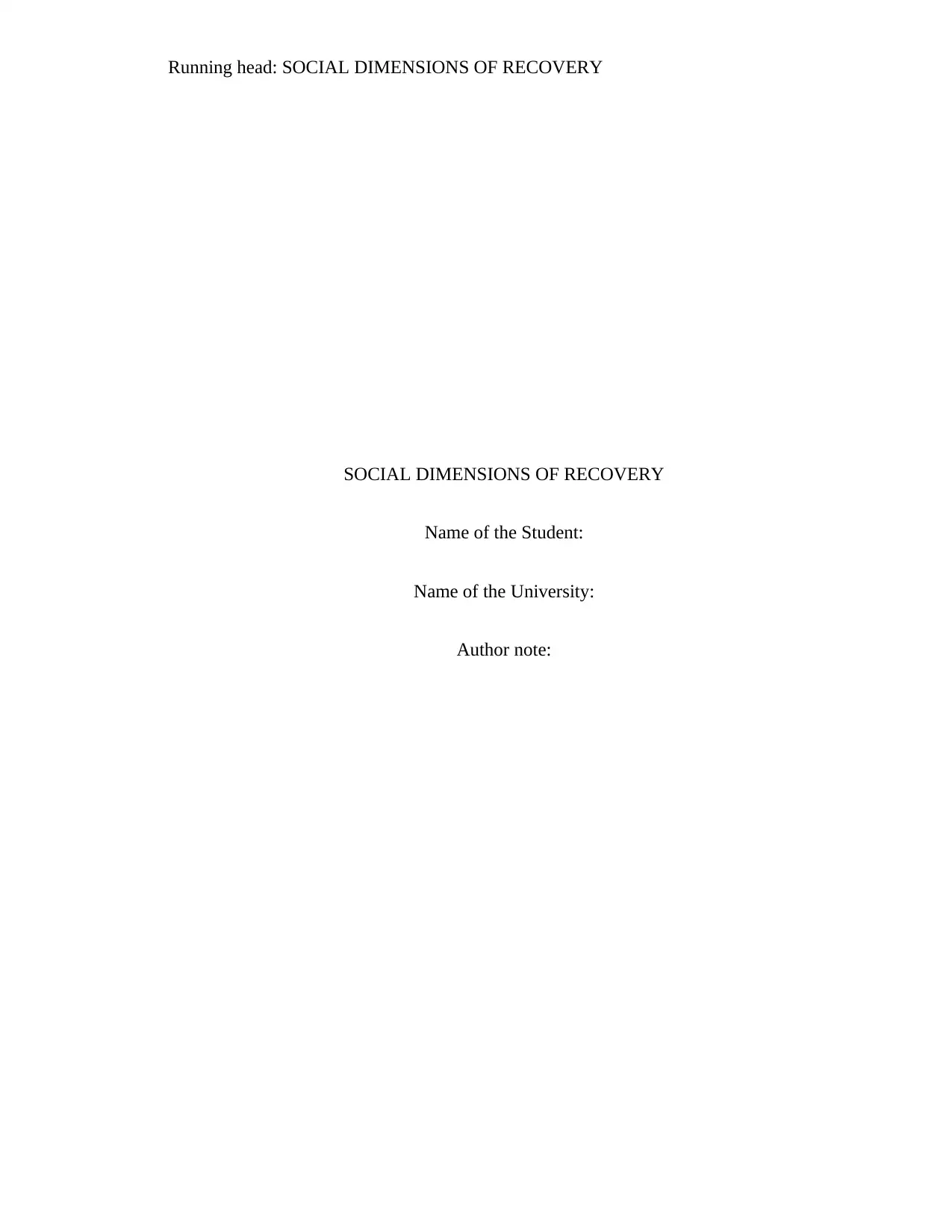
Running head: SOCIAL DIMENSIONS OF RECOVERY
SOCIAL DIMENSIONS OF RECOVERY
Name of the Student:
Name of the University:
Author note:
SOCIAL DIMENSIONS OF RECOVERY
Name of the Student:
Name of the University:
Author note:
Paraphrase This Document
Need a fresh take? Get an instant paraphrase of this document with our AI Paraphraser
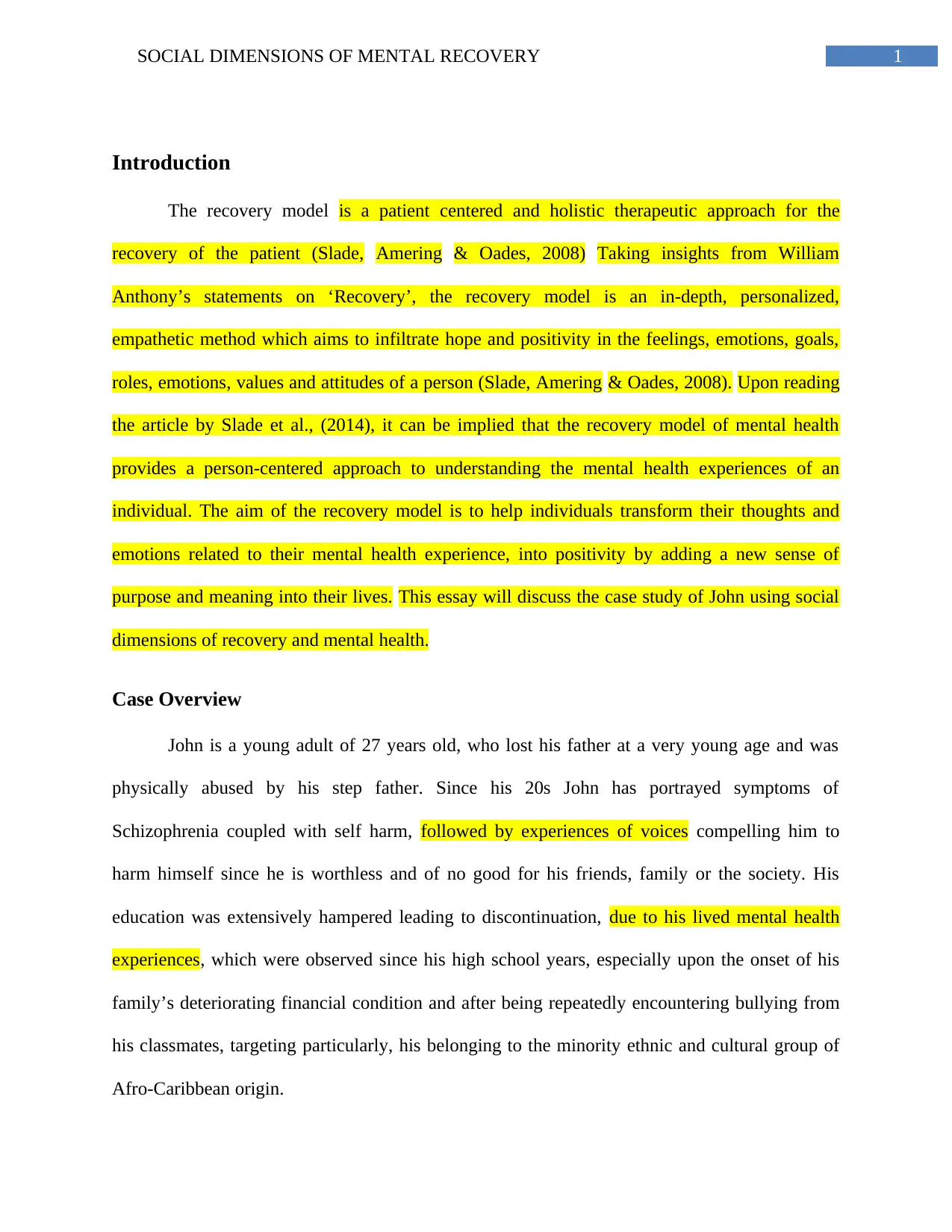
1SOCIAL DIMENSIONS OF MENTAL RECOVERY
Introduction
The recovery model is a patient centered and holistic therapeutic approach for the
recovery of the patient (Slade, Amering & Oades, 2008) Taking insights from William
Anthony’s statements on ‘Recovery’, the recovery model is an in-depth, personalized,
empathetic method which aims to infiltrate hope and positivity in the feelings, emotions, goals,
roles, emotions, values and attitudes of a person (Slade, Amering & Oades, 2008). Upon reading
the article by Slade et al., (2014), it can be implied that the recovery model of mental health
provides a person-centered approach to understanding the mental health experiences of an
individual. The aim of the recovery model is to help individuals transform their thoughts and
emotions related to their mental health experience, into positivity by adding a new sense of
purpose and meaning into their lives. This essay will discuss the case study of John using social
dimensions of recovery and mental health.
Case Overview
John is a young adult of 27 years old, who lost his father at a very young age and was
physically abused by his step father. Since his 20s John has portrayed symptoms of
Schizophrenia coupled with self harm, followed by experiences of voices compelling him to
harm himself since he is worthless and of no good for his friends, family or the society. His
education was extensively hampered leading to discontinuation, due to his lived mental health
experiences, which were observed since his high school years, especially upon the onset of his
family’s deteriorating financial condition and after being repeatedly encountering bullying from
his classmates, targeting particularly, his belonging to the minority ethnic and cultural group of
Afro-Caribbean origin.
Introduction
The recovery model is a patient centered and holistic therapeutic approach for the
recovery of the patient (Slade, Amering & Oades, 2008) Taking insights from William
Anthony’s statements on ‘Recovery’, the recovery model is an in-depth, personalized,
empathetic method which aims to infiltrate hope and positivity in the feelings, emotions, goals,
roles, emotions, values and attitudes of a person (Slade, Amering & Oades, 2008). Upon reading
the article by Slade et al., (2014), it can be implied that the recovery model of mental health
provides a person-centered approach to understanding the mental health experiences of an
individual. The aim of the recovery model is to help individuals transform their thoughts and
emotions related to their mental health experience, into positivity by adding a new sense of
purpose and meaning into their lives. This essay will discuss the case study of John using social
dimensions of recovery and mental health.
Case Overview
John is a young adult of 27 years old, who lost his father at a very young age and was
physically abused by his step father. Since his 20s John has portrayed symptoms of
Schizophrenia coupled with self harm, followed by experiences of voices compelling him to
harm himself since he is worthless and of no good for his friends, family or the society. His
education was extensively hampered leading to discontinuation, due to his lived mental health
experiences, which were observed since his high school years, especially upon the onset of his
family’s deteriorating financial condition and after being repeatedly encountering bullying from
his classmates, targeting particularly, his belonging to the minority ethnic and cultural group of
Afro-Caribbean origin.

2SOCIAL DIMENSIONS OF MENTAL RECOVERY
Discussion
Overview of Social Model of Health
According to Wallace et al., (2015), social model encourages health professionals to
emphasize an individual’s lived mental health experiences and focus on the various social
dimensions of recovery, health and experiences. As researched by Sallis, Owen and Fisher
(2015), the social model of health implies that the health of an individual is affected by social
factors like organization, interpersonal, environmental, political, organization, social, economical
and individual aspects. Gaining insights from Bourassa, Memel, Woolverton and Sbarra (2017) ,
the social model of health believes that only concentrating on biological and physiological
symptoms prevent us from holistically empathizing with the lived mental health experiences of
an individuals. For this reason, health professionals must consider the social dimensions of such
as identity, employment, power relations, stigma, discrimination, interpersonal relationships,
social inclusion and social capital (Tew, Ramon, Slade, Bird, Melton & Le Boutillier, 2012).
Further, as researched by Vernooij-Dassen and Jeon (2016 the social model of health gives
importance on the gender, ethnicity and cultural diversity, since such social factors also largely
influence how individuals understand their lived mental health experiences. Similarly, as
observed by Weisz, Quinn and Williams (2016), the social model of health encourages
professionals to provide culturally competent care, by recognizing that individuals from diverse
ethnicities and cultures view their lived mental health experiences uniquely. From the research
by Murali and Oyebode, F. (2004), it can be understood that the existing socioeconomic factors
of the community in which the individual resides in, also influence the health of a person. As
researched by Best (2016), the social model of health also states the importance of considering
the needs and opinions of individuals belonging non-medical backgrounds. Hence, we must
Discussion
Overview of Social Model of Health
According to Wallace et al., (2015), social model encourages health professionals to
emphasize an individual’s lived mental health experiences and focus on the various social
dimensions of recovery, health and experiences. As researched by Sallis, Owen and Fisher
(2015), the social model of health implies that the health of an individual is affected by social
factors like organization, interpersonal, environmental, political, organization, social, economical
and individual aspects. Gaining insights from Bourassa, Memel, Woolverton and Sbarra (2017) ,
the social model of health believes that only concentrating on biological and physiological
symptoms prevent us from holistically empathizing with the lived mental health experiences of
an individuals. For this reason, health professionals must consider the social dimensions of such
as identity, employment, power relations, stigma, discrimination, interpersonal relationships,
social inclusion and social capital (Tew, Ramon, Slade, Bird, Melton & Le Boutillier, 2012).
Further, as researched by Vernooij-Dassen and Jeon (2016 the social model of health gives
importance on the gender, ethnicity and cultural diversity, since such social factors also largely
influence how individuals understand their lived mental health experiences. Similarly, as
observed by Weisz, Quinn and Williams (2016), the social model of health encourages
professionals to provide culturally competent care, by recognizing that individuals from diverse
ethnicities and cultures view their lived mental health experiences uniquely. From the research
by Murali and Oyebode, F. (2004), it can be understood that the existing socioeconomic factors
of the community in which the individual resides in, also influence the health of a person. As
researched by Best (2016), the social model of health also states the importance of considering
the needs and opinions of individuals belonging non-medical backgrounds. Hence, we must
⊘ This is a preview!⊘
Do you want full access?
Subscribe today to unlock all pages.

Trusted by 1+ million students worldwide
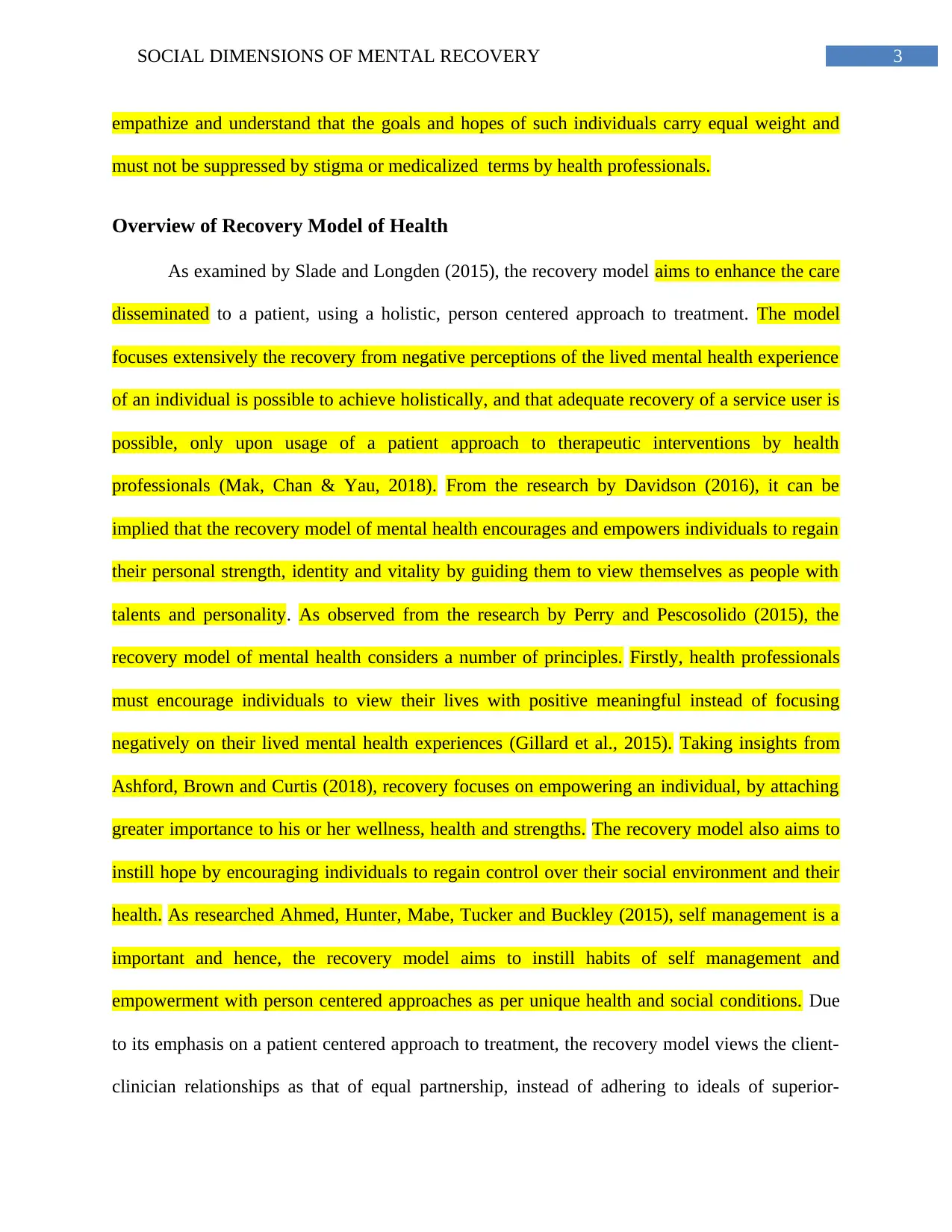
3SOCIAL DIMENSIONS OF MENTAL RECOVERY
empathize and understand that the goals and hopes of such individuals carry equal weight and
must not be suppressed by stigma or medicalized terms by health professionals.
Overview of Recovery Model of Health
As examined by Slade and Longden (2015), the recovery model aims to enhance the care
disseminated to a patient, using a holistic, person centered approach to treatment. The model
focuses extensively the recovery from negative perceptions of the lived mental health experience
of an individual is possible to achieve holistically, and that adequate recovery of a service user is
possible, only upon usage of a patient approach to therapeutic interventions by health
professionals (Mak, Chan & Yau, 2018). From the research by Davidson (2016), it can be
implied that the recovery model of mental health encourages and empowers individuals to regain
their personal strength, identity and vitality by guiding them to view themselves as people with
talents and personality. As observed from the research by Perry and Pescosolido (2015), the
recovery model of mental health considers a number of principles. Firstly, health professionals
must encourage individuals to view their lives with positive meaningful instead of focusing
negatively on their lived mental health experiences (Gillard et al., 2015). Taking insights from
Ashford, Brown and Curtis (2018), recovery focuses on empowering an individual, by attaching
greater importance to his or her wellness, health and strengths. The recovery model also aims to
instill hope by encouraging individuals to regain control over their social environment and their
health. As researched Ahmed, Hunter, Mabe, Tucker and Buckley (2015), self management is a
important and hence, the recovery model aims to instill habits of self management and
empowerment with person centered approaches as per unique health and social conditions. Due
to its emphasis on a patient centered approach to treatment, the recovery model views the client-
clinician relationships as that of equal partnership, instead of adhering to ideals of superior-
empathize and understand that the goals and hopes of such individuals carry equal weight and
must not be suppressed by stigma or medicalized terms by health professionals.
Overview of Recovery Model of Health
As examined by Slade and Longden (2015), the recovery model aims to enhance the care
disseminated to a patient, using a holistic, person centered approach to treatment. The model
focuses extensively the recovery from negative perceptions of the lived mental health experience
of an individual is possible to achieve holistically, and that adequate recovery of a service user is
possible, only upon usage of a patient approach to therapeutic interventions by health
professionals (Mak, Chan & Yau, 2018). From the research by Davidson (2016), it can be
implied that the recovery model of mental health encourages and empowers individuals to regain
their personal strength, identity and vitality by guiding them to view themselves as people with
talents and personality. As observed from the research by Perry and Pescosolido (2015), the
recovery model of mental health considers a number of principles. Firstly, health professionals
must encourage individuals to view their lives with positive meaningful instead of focusing
negatively on their lived mental health experiences (Gillard et al., 2015). Taking insights from
Ashford, Brown and Curtis (2018), recovery focuses on empowering an individual, by attaching
greater importance to his or her wellness, health and strengths. The recovery model also aims to
instill hope by encouraging individuals to regain control over their social environment and their
health. As researched Ahmed, Hunter, Mabe, Tucker and Buckley (2015), self management is a
important and hence, the recovery model aims to instill habits of self management and
empowerment with person centered approaches as per unique health and social conditions. Due
to its emphasis on a patient centered approach to treatment, the recovery model views the client-
clinician relationships as that of equal partnership, instead of adhering to ideals of superior-
Paraphrase This Document
Need a fresh take? Get an instant paraphrase of this document with our AI Paraphraser
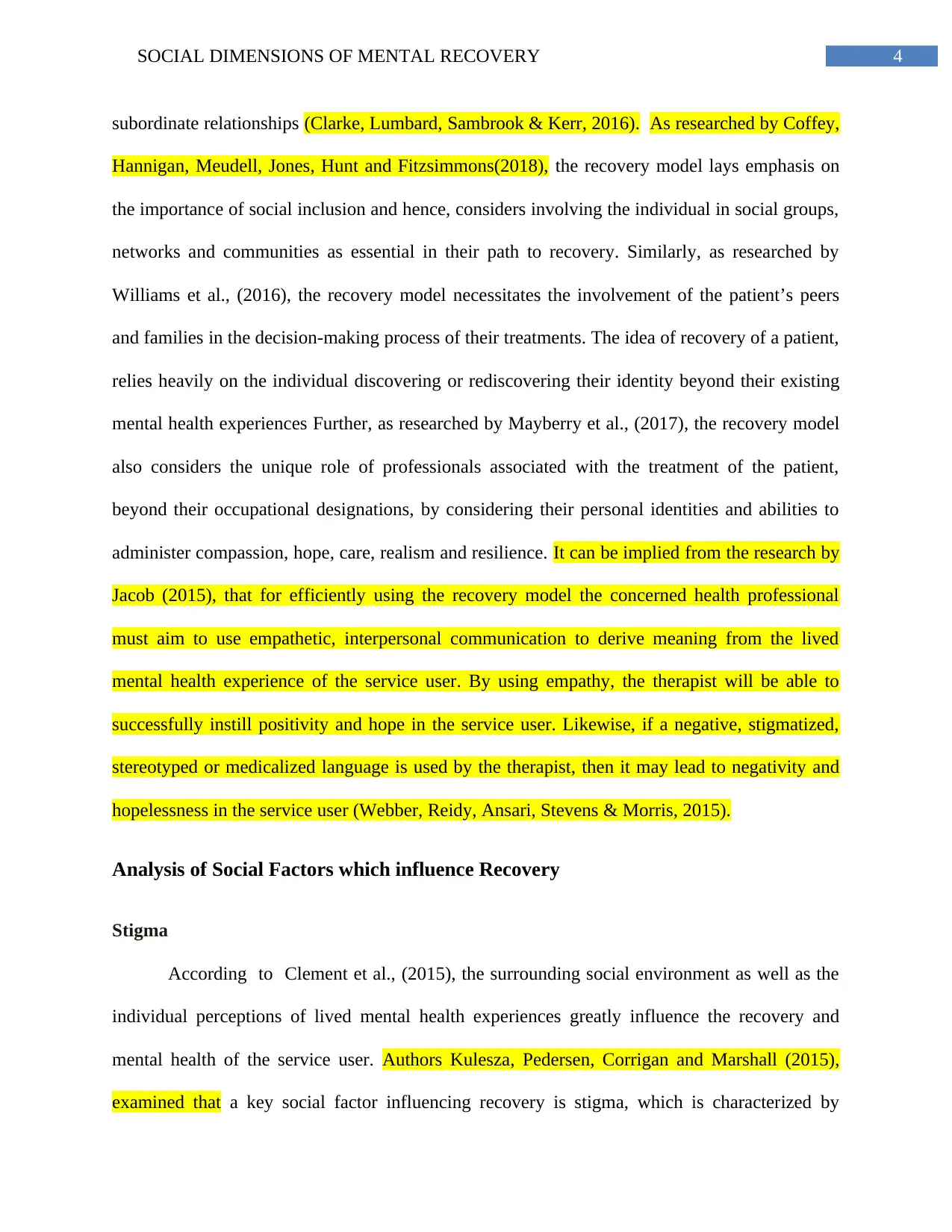
4SOCIAL DIMENSIONS OF MENTAL RECOVERY
subordinate relationships (Clarke, Lumbard, Sambrook & Kerr, 2016). As researched by Coffey,
Hannigan, Meudell, Jones, Hunt and Fitzsimmons(2018), the recovery model lays emphasis on
the importance of social inclusion and hence, considers involving the individual in social groups,
networks and communities as essential in their path to recovery. Similarly, as researched by
Williams et al., (2016), the recovery model necessitates the involvement of the patient’s peers
and families in the decision-making process of their treatments. The idea of recovery of a patient,
relies heavily on the individual discovering or rediscovering their identity beyond their existing
mental health experiences Further, as researched by Mayberry et al., (2017), the recovery model
also considers the unique role of professionals associated with the treatment of the patient,
beyond their occupational designations, by considering their personal identities and abilities to
administer compassion, hope, care, realism and resilience. It can be implied from the research by
Jacob (2015), that for efficiently using the recovery model the concerned health professional
must aim to use empathetic, interpersonal communication to derive meaning from the lived
mental health experience of the service user. By using empathy, the therapist will be able to
successfully instill positivity and hope in the service user. Likewise, if a negative, stigmatized,
stereotyped or medicalized language is used by the therapist, then it may lead to negativity and
hopelessness in the service user (Webber, Reidy, Ansari, Stevens & Morris, 2015).
Analysis of Social Factors which influence Recovery
Stigma
According to Clement et al., (2015), the surrounding social environment as well as the
individual perceptions of lived mental health experiences greatly influence the recovery and
mental health of the service user. Authors Kulesza, Pedersen, Corrigan and Marshall (2015),
examined that a key social factor influencing recovery is stigma, which is characterized by
subordinate relationships (Clarke, Lumbard, Sambrook & Kerr, 2016). As researched by Coffey,
Hannigan, Meudell, Jones, Hunt and Fitzsimmons(2018), the recovery model lays emphasis on
the importance of social inclusion and hence, considers involving the individual in social groups,
networks and communities as essential in their path to recovery. Similarly, as researched by
Williams et al., (2016), the recovery model necessitates the involvement of the patient’s peers
and families in the decision-making process of their treatments. The idea of recovery of a patient,
relies heavily on the individual discovering or rediscovering their identity beyond their existing
mental health experiences Further, as researched by Mayberry et al., (2017), the recovery model
also considers the unique role of professionals associated with the treatment of the patient,
beyond their occupational designations, by considering their personal identities and abilities to
administer compassion, hope, care, realism and resilience. It can be implied from the research by
Jacob (2015), that for efficiently using the recovery model the concerned health professional
must aim to use empathetic, interpersonal communication to derive meaning from the lived
mental health experience of the service user. By using empathy, the therapist will be able to
successfully instill positivity and hope in the service user. Likewise, if a negative, stigmatized,
stereotyped or medicalized language is used by the therapist, then it may lead to negativity and
hopelessness in the service user (Webber, Reidy, Ansari, Stevens & Morris, 2015).
Analysis of Social Factors which influence Recovery
Stigma
According to Clement et al., (2015), the surrounding social environment as well as the
individual perceptions of lived mental health experiences greatly influence the recovery and
mental health of the service user. Authors Kulesza, Pedersen, Corrigan and Marshall (2015),
examined that a key social factor influencing recovery is stigma, which is characterized by
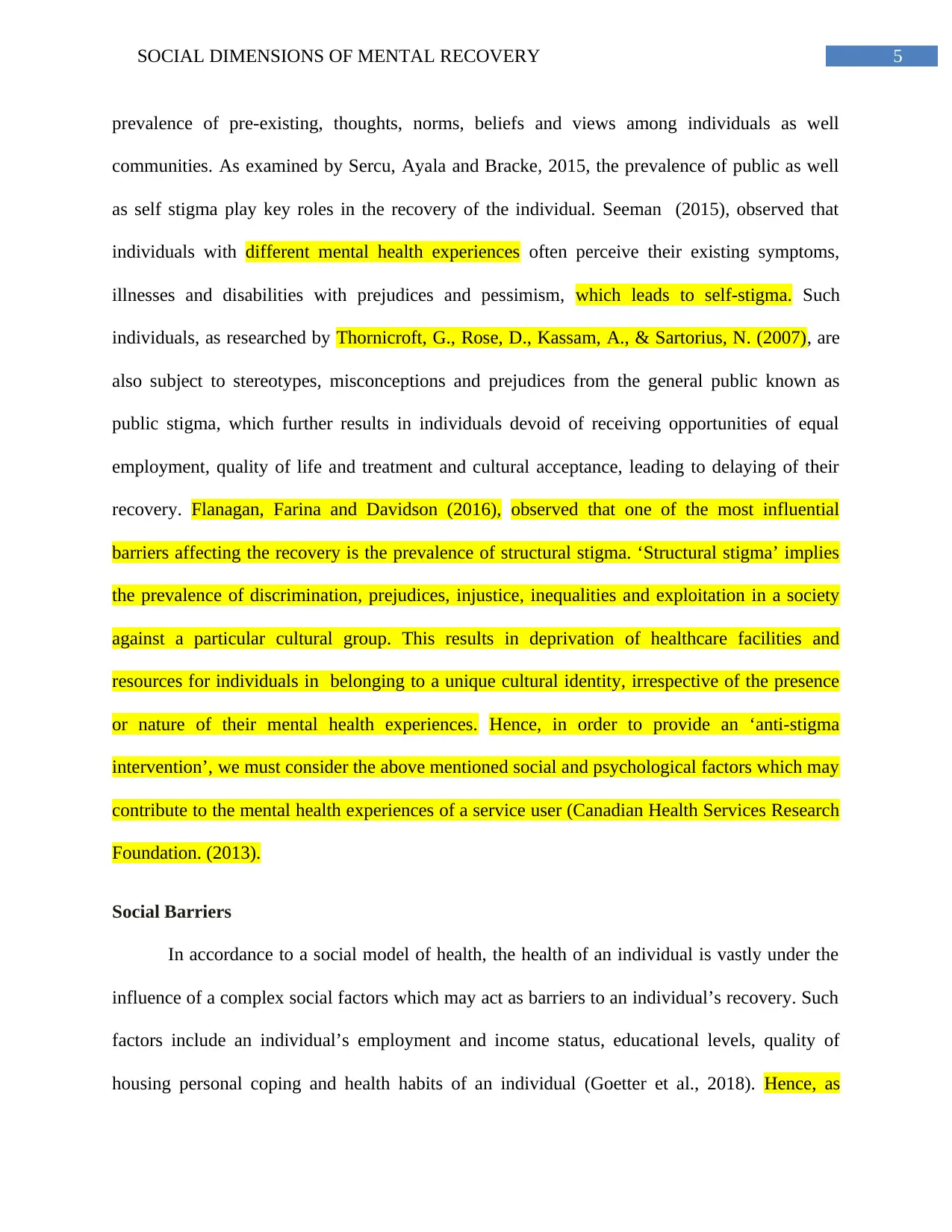
5SOCIAL DIMENSIONS OF MENTAL RECOVERY
prevalence of pre-existing, thoughts, norms, beliefs and views among individuals as well
communities. As examined by Sercu, Ayala and Bracke, 2015, the prevalence of public as well
as self stigma play key roles in the recovery of the individual. Seeman (2015), observed that
individuals with different mental health experiences often perceive their existing symptoms,
illnesses and disabilities with prejudices and pessimism, which leads to self-stigma. Such
individuals, as researched by Thornicroft, G., Rose, D., Kassam, A., & Sartorius, N. (2007), are
also subject to stereotypes, misconceptions and prejudices from the general public known as
public stigma, which further results in individuals devoid of receiving opportunities of equal
employment, quality of life and treatment and cultural acceptance, leading to delaying of their
recovery. Flanagan, Farina and Davidson (2016), observed that one of the most influential
barriers affecting the recovery is the prevalence of structural stigma. ‘Structural stigma’ implies
the prevalence of discrimination, prejudices, injustice, inequalities and exploitation in a society
against a particular cultural group. This results in deprivation of healthcare facilities and
resources for individuals in belonging to a unique cultural identity, irrespective of the presence
or nature of their mental health experiences. Hence, in order to provide an ‘anti-stigma
intervention’, we must consider the above mentioned social and psychological factors which may
contribute to the mental health experiences of a service user (Canadian Health Services Research
Foundation. (2013).
Social Barriers
In accordance to a social model of health, the health of an individual is vastly under the
influence of a complex social factors which may act as barriers to an individual’s recovery. Such
factors include an individual’s employment and income status, educational levels, quality of
housing personal coping and health habits of an individual (Goetter et al., 2018). Hence, as
prevalence of pre-existing, thoughts, norms, beliefs and views among individuals as well
communities. As examined by Sercu, Ayala and Bracke, 2015, the prevalence of public as well
as self stigma play key roles in the recovery of the individual. Seeman (2015), observed that
individuals with different mental health experiences often perceive their existing symptoms,
illnesses and disabilities with prejudices and pessimism, which leads to self-stigma. Such
individuals, as researched by Thornicroft, G., Rose, D., Kassam, A., & Sartorius, N. (2007), are
also subject to stereotypes, misconceptions and prejudices from the general public known as
public stigma, which further results in individuals devoid of receiving opportunities of equal
employment, quality of life and treatment and cultural acceptance, leading to delaying of their
recovery. Flanagan, Farina and Davidson (2016), observed that one of the most influential
barriers affecting the recovery is the prevalence of structural stigma. ‘Structural stigma’ implies
the prevalence of discrimination, prejudices, injustice, inequalities and exploitation in a society
against a particular cultural group. This results in deprivation of healthcare facilities and
resources for individuals in belonging to a unique cultural identity, irrespective of the presence
or nature of their mental health experiences. Hence, in order to provide an ‘anti-stigma
intervention’, we must consider the above mentioned social and psychological factors which may
contribute to the mental health experiences of a service user (Canadian Health Services Research
Foundation. (2013).
Social Barriers
In accordance to a social model of health, the health of an individual is vastly under the
influence of a complex social factors which may act as barriers to an individual’s recovery. Such
factors include an individual’s employment and income status, educational levels, quality of
housing personal coping and health habits of an individual (Goetter et al., 2018). Hence, as
⊘ This is a preview!⊘
Do you want full access?
Subscribe today to unlock all pages.

Trusted by 1+ million students worldwide
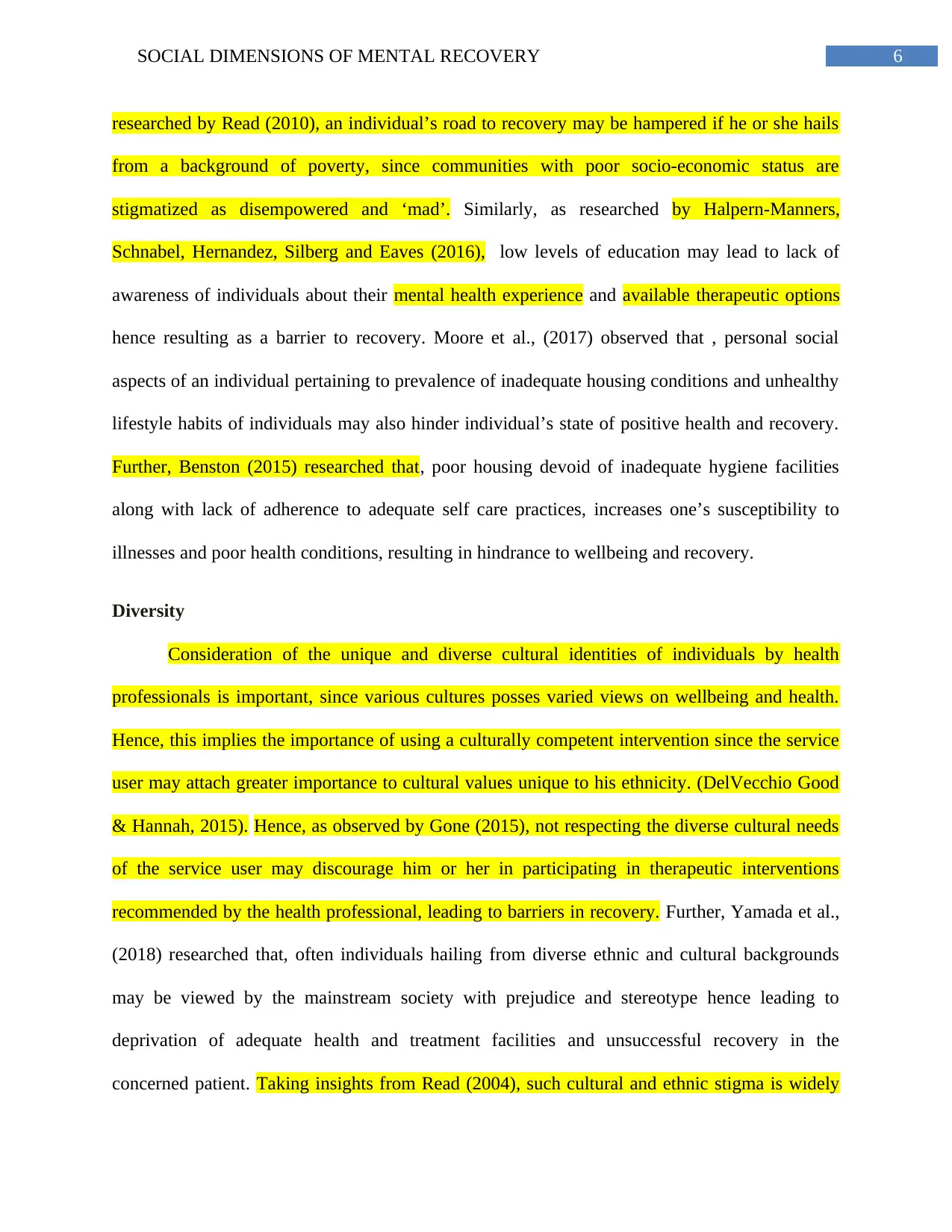
6SOCIAL DIMENSIONS OF MENTAL RECOVERY
researched by Read (2010), an individual’s road to recovery may be hampered if he or she hails
from a background of poverty, since communities with poor socio-economic status are
stigmatized as disempowered and ‘mad’. Similarly, as researched by Halpern-Manners,
Schnabel, Hernandez, Silberg and Eaves (2016), low levels of education may lead to lack of
awareness of individuals about their mental health experience and available therapeutic options
hence resulting as a barrier to recovery. Moore et al., (2017) observed that , personal social
aspects of an individual pertaining to prevalence of inadequate housing conditions and unhealthy
lifestyle habits of individuals may also hinder individual’s state of positive health and recovery.
Further, Benston (2015) researched that, poor housing devoid of inadequate hygiene facilities
along with lack of adherence to adequate self care practices, increases one’s susceptibility to
illnesses and poor health conditions, resulting in hindrance to wellbeing and recovery.
Diversity
Consideration of the unique and diverse cultural identities of individuals by health
professionals is important, since various cultures posses varied views on wellbeing and health.
Hence, this implies the importance of using a culturally competent intervention since the service
user may attach greater importance to cultural values unique to his ethnicity. (DelVecchio Good
& Hannah, 2015). Hence, as observed by Gone (2015), not respecting the diverse cultural needs
of the service user may discourage him or her in participating in therapeutic interventions
recommended by the health professional, leading to barriers in recovery. Further, Yamada et al.,
(2018) researched that, often individuals hailing from diverse ethnic and cultural backgrounds
may be viewed by the mainstream society with prejudice and stereotype hence leading to
deprivation of adequate health and treatment facilities and unsuccessful recovery in the
concerned patient. Taking insights from Read (2004), such cultural and ethnic stigma is widely
researched by Read (2010), an individual’s road to recovery may be hampered if he or she hails
from a background of poverty, since communities with poor socio-economic status are
stigmatized as disempowered and ‘mad’. Similarly, as researched by Halpern-Manners,
Schnabel, Hernandez, Silberg and Eaves (2016), low levels of education may lead to lack of
awareness of individuals about their mental health experience and available therapeutic options
hence resulting as a barrier to recovery. Moore et al., (2017) observed that , personal social
aspects of an individual pertaining to prevalence of inadequate housing conditions and unhealthy
lifestyle habits of individuals may also hinder individual’s state of positive health and recovery.
Further, Benston (2015) researched that, poor housing devoid of inadequate hygiene facilities
along with lack of adherence to adequate self care practices, increases one’s susceptibility to
illnesses and poor health conditions, resulting in hindrance to wellbeing and recovery.
Diversity
Consideration of the unique and diverse cultural identities of individuals by health
professionals is important, since various cultures posses varied views on wellbeing and health.
Hence, this implies the importance of using a culturally competent intervention since the service
user may attach greater importance to cultural values unique to his ethnicity. (DelVecchio Good
& Hannah, 2015). Hence, as observed by Gone (2015), not respecting the diverse cultural needs
of the service user may discourage him or her in participating in therapeutic interventions
recommended by the health professional, leading to barriers in recovery. Further, Yamada et al.,
(2018) researched that, often individuals hailing from diverse ethnic and cultural backgrounds
may be viewed by the mainstream society with prejudice and stereotype hence leading to
deprivation of adequate health and treatment facilities and unsuccessful recovery in the
concerned patient. Taking insights from Read (2004), such cultural and ethnic stigma is widely
Paraphrase This Document
Need a fresh take? Get an instant paraphrase of this document with our AI Paraphraser
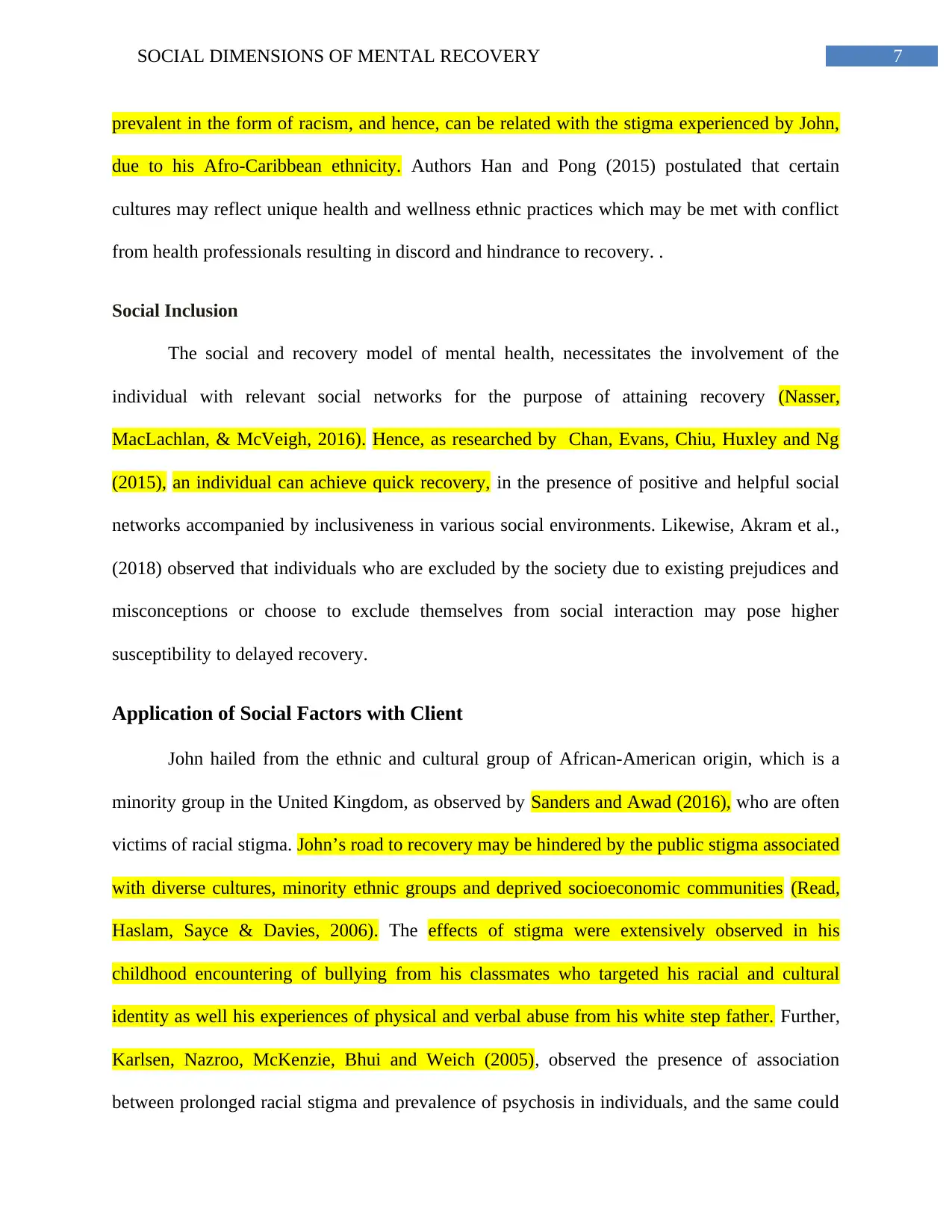
7SOCIAL DIMENSIONS OF MENTAL RECOVERY
prevalent in the form of racism, and hence, can be related with the stigma experienced by John,
due to his Afro-Caribbean ethnicity. Authors Han and Pong (2015) postulated that certain
cultures may reflect unique health and wellness ethnic practices which may be met with conflict
from health professionals resulting in discord and hindrance to recovery. .
Social Inclusion
The social and recovery model of mental health, necessitates the involvement of the
individual with relevant social networks for the purpose of attaining recovery (Nasser,
MacLachlan, & McVeigh, 2016). Hence, as researched by Chan, Evans, Chiu, Huxley and Ng
(2015), an individual can achieve quick recovery, in the presence of positive and helpful social
networks accompanied by inclusiveness in various social environments. Likewise, Akram et al.,
(2018) observed that individuals who are excluded by the society due to existing prejudices and
misconceptions or choose to exclude themselves from social interaction may pose higher
susceptibility to delayed recovery.
Application of Social Factors with Client
John hailed from the ethnic and cultural group of African-American origin, which is a
minority group in the United Kingdom, as observed by Sanders and Awad (2016), who are often
victims of racial stigma. John’s road to recovery may be hindered by the public stigma associated
with diverse cultures, minority ethnic groups and deprived socioeconomic communities (Read,
Haslam, Sayce & Davies, 2006). The effects of stigma were extensively observed in his
childhood encountering of bullying from his classmates who targeted his racial and cultural
identity as well his experiences of physical and verbal abuse from his white step father. Further,
Karlsen, Nazroo, McKenzie, Bhui and Weich (2005), observed the presence of association
between prolonged racial stigma and prevalence of psychosis in individuals, and the same could
prevalent in the form of racism, and hence, can be related with the stigma experienced by John,
due to his Afro-Caribbean ethnicity. Authors Han and Pong (2015) postulated that certain
cultures may reflect unique health and wellness ethnic practices which may be met with conflict
from health professionals resulting in discord and hindrance to recovery. .
Social Inclusion
The social and recovery model of mental health, necessitates the involvement of the
individual with relevant social networks for the purpose of attaining recovery (Nasser,
MacLachlan, & McVeigh, 2016). Hence, as researched by Chan, Evans, Chiu, Huxley and Ng
(2015), an individual can achieve quick recovery, in the presence of positive and helpful social
networks accompanied by inclusiveness in various social environments. Likewise, Akram et al.,
(2018) observed that individuals who are excluded by the society due to existing prejudices and
misconceptions or choose to exclude themselves from social interaction may pose higher
susceptibility to delayed recovery.
Application of Social Factors with Client
John hailed from the ethnic and cultural group of African-American origin, which is a
minority group in the United Kingdom, as observed by Sanders and Awad (2016), who are often
victims of racial stigma. John’s road to recovery may be hindered by the public stigma associated
with diverse cultures, minority ethnic groups and deprived socioeconomic communities (Read,
Haslam, Sayce & Davies, 2006). The effects of stigma were extensively observed in his
childhood encountering of bullying from his classmates who targeted his racial and cultural
identity as well his experiences of physical and verbal abuse from his white step father. Further,
Karlsen, Nazroo, McKenzie, Bhui and Weich (2005), observed the presence of association
between prolonged racial stigma and prevalence of psychosis in individuals, and the same could

8SOCIAL DIMENSIONS OF MENTAL RECOVERY
be extensively observed in John, who was found to possess considerable stigmatized views
concerning himself as incompetent and unworthy, which we observed by empathizing with his
mental health experience of hearing ‘voices directing him to harm himself’. John also considered
his mental condition as a liability, and hence, such misconception and personal stigma
concerning himself may delay John’s path to recovery, as observed in the study conducted by
Brinkley-Rubinstein (2015).
Further, we faced difficulty while educating John on the usage of a recovery model of
therapy, as observed in his reluctance and worry on the effectiveness of the same. This was due
to his fear that he may be stigmatized by us considering his incomplete educational background
and diverse ethnicity, just like ‘everyone else in his life’. Hence, we patiently empathized John
and explain him the principles of Recovery, which were observed to reduce his fear – hence
highlighting ‘interconnectedness’ and ‘interpersonal relationships’ as social dimensions which
greatly affect a service users mental health experiences (Tew, Ramon, Slade, Bird, Melton & Le
Boutillier, 2011). Hence, taking note of the study conducted by Zimmerman, Woolf and Haley
(2015), as discussed previously, John’s lack of adequate educational status may result in
difficulties during treatment and recovery due to the public stigma associated with individuals
with inadequate educational status. Further, John’s tendencies of harmful health practices in the
form of self harming behaviors, may delay his recovery processes, since personal health factors
may key social roles in accordance to the social model of health (Dyrbye, Satele & Shanafelt,
2017).
As researched by Leamy et al., (2016), an individual’s diverse cultural and ethnic
background plays a key role in the determination of their recovery process. Further, Tang (2016)
observed that, due to public and social stigmas, an individual belonging to minority backgrounds,
be extensively observed in John, who was found to possess considerable stigmatized views
concerning himself as incompetent and unworthy, which we observed by empathizing with his
mental health experience of hearing ‘voices directing him to harm himself’. John also considered
his mental condition as a liability, and hence, such misconception and personal stigma
concerning himself may delay John’s path to recovery, as observed in the study conducted by
Brinkley-Rubinstein (2015).
Further, we faced difficulty while educating John on the usage of a recovery model of
therapy, as observed in his reluctance and worry on the effectiveness of the same. This was due
to his fear that he may be stigmatized by us considering his incomplete educational background
and diverse ethnicity, just like ‘everyone else in his life’. Hence, we patiently empathized John
and explain him the principles of Recovery, which were observed to reduce his fear – hence
highlighting ‘interconnectedness’ and ‘interpersonal relationships’ as social dimensions which
greatly affect a service users mental health experiences (Tew, Ramon, Slade, Bird, Melton & Le
Boutillier, 2011). Hence, taking note of the study conducted by Zimmerman, Woolf and Haley
(2015), as discussed previously, John’s lack of adequate educational status may result in
difficulties during treatment and recovery due to the public stigma associated with individuals
with inadequate educational status. Further, John’s tendencies of harmful health practices in the
form of self harming behaviors, may delay his recovery processes, since personal health factors
may key social roles in accordance to the social model of health (Dyrbye, Satele & Shanafelt,
2017).
As researched by Leamy et al., (2016), an individual’s diverse cultural and ethnic
background plays a key role in the determination of their recovery process. Further, Tang (2016)
observed that, due to public and social stigmas, an individual belonging to minority backgrounds,
⊘ This is a preview!⊘
Do you want full access?
Subscribe today to unlock all pages.

Trusted by 1+ million students worldwide
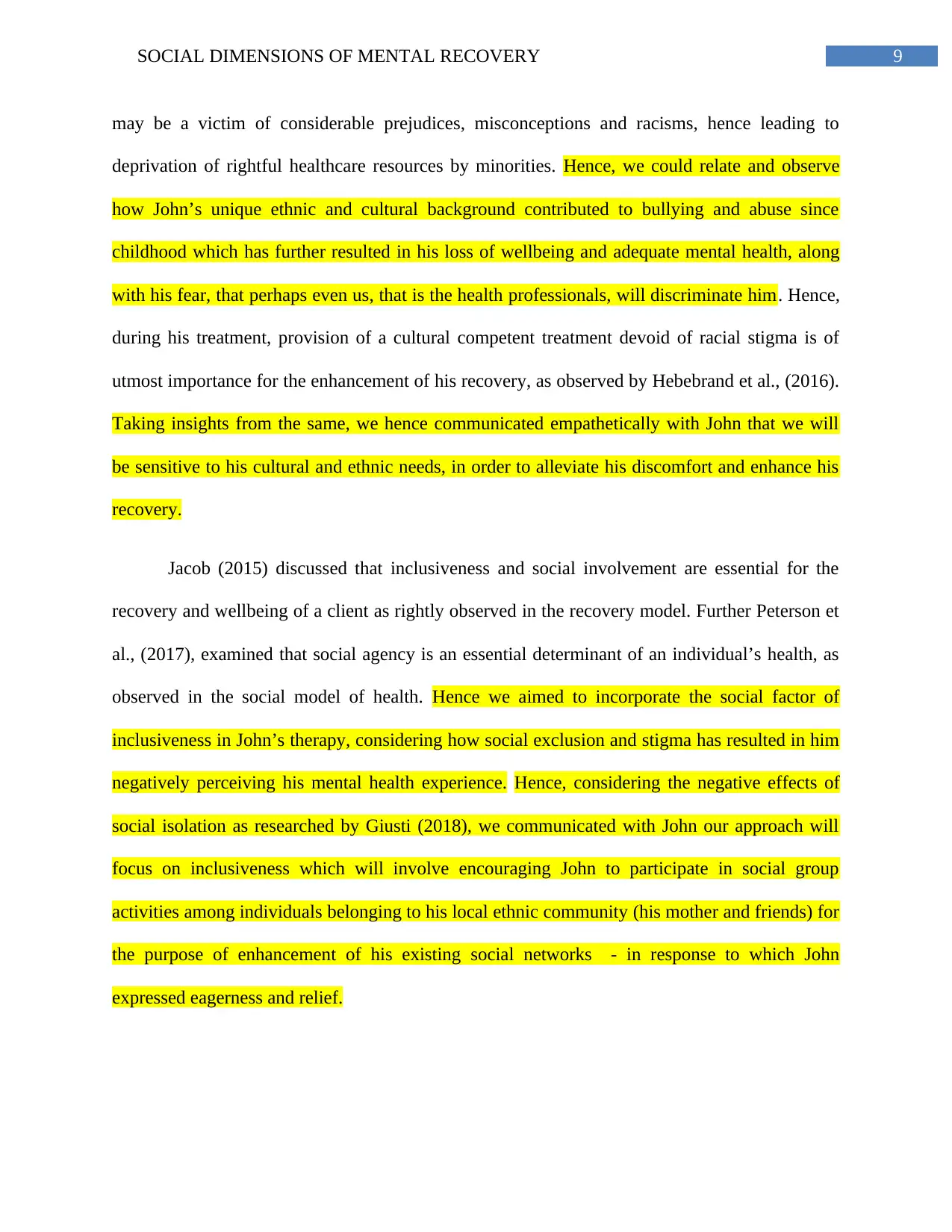
9SOCIAL DIMENSIONS OF MENTAL RECOVERY
may be a victim of considerable prejudices, misconceptions and racisms, hence leading to
deprivation of rightful healthcare resources by minorities. Hence, we could relate and observe
how John’s unique ethnic and cultural background contributed to bullying and abuse since
childhood which has further resulted in his loss of wellbeing and adequate mental health, along
with his fear, that perhaps even us, that is the health professionals, will discriminate him. Hence,
during his treatment, provision of a cultural competent treatment devoid of racial stigma is of
utmost importance for the enhancement of his recovery, as observed by Hebebrand et al., (2016).
Taking insights from the same, we hence communicated empathetically with John that we will
be sensitive to his cultural and ethnic needs, in order to alleviate his discomfort and enhance his
recovery.
Jacob (2015) discussed that inclusiveness and social involvement are essential for the
recovery and wellbeing of a client as rightly observed in the recovery model. Further Peterson et
al., (2017), examined that social agency is an essential determinant of an individual’s health, as
observed in the social model of health. Hence we aimed to incorporate the social factor of
inclusiveness in John’s therapy, considering how social exclusion and stigma has resulted in him
negatively perceiving his mental health experience. Hence, considering the negative effects of
social isolation as researched by Giusti (2018), we communicated with John our approach will
focus on inclusiveness which will involve encouraging John to participate in social group
activities among individuals belonging to his local ethnic community (his mother and friends) for
the purpose of enhancement of his existing social networks - in response to which John
expressed eagerness and relief.
may be a victim of considerable prejudices, misconceptions and racisms, hence leading to
deprivation of rightful healthcare resources by minorities. Hence, we could relate and observe
how John’s unique ethnic and cultural background contributed to bullying and abuse since
childhood which has further resulted in his loss of wellbeing and adequate mental health, along
with his fear, that perhaps even us, that is the health professionals, will discriminate him. Hence,
during his treatment, provision of a cultural competent treatment devoid of racial stigma is of
utmost importance for the enhancement of his recovery, as observed by Hebebrand et al., (2016).
Taking insights from the same, we hence communicated empathetically with John that we will
be sensitive to his cultural and ethnic needs, in order to alleviate his discomfort and enhance his
recovery.
Jacob (2015) discussed that inclusiveness and social involvement are essential for the
recovery and wellbeing of a client as rightly observed in the recovery model. Further Peterson et
al., (2017), examined that social agency is an essential determinant of an individual’s health, as
observed in the social model of health. Hence we aimed to incorporate the social factor of
inclusiveness in John’s therapy, considering how social exclusion and stigma has resulted in him
negatively perceiving his mental health experience. Hence, considering the negative effects of
social isolation as researched by Giusti (2018), we communicated with John our approach will
focus on inclusiveness which will involve encouraging John to participate in social group
activities among individuals belonging to his local ethnic community (his mother and friends) for
the purpose of enhancement of his existing social networks - in response to which John
expressed eagerness and relief.
Paraphrase This Document
Need a fresh take? Get an instant paraphrase of this document with our AI Paraphraser
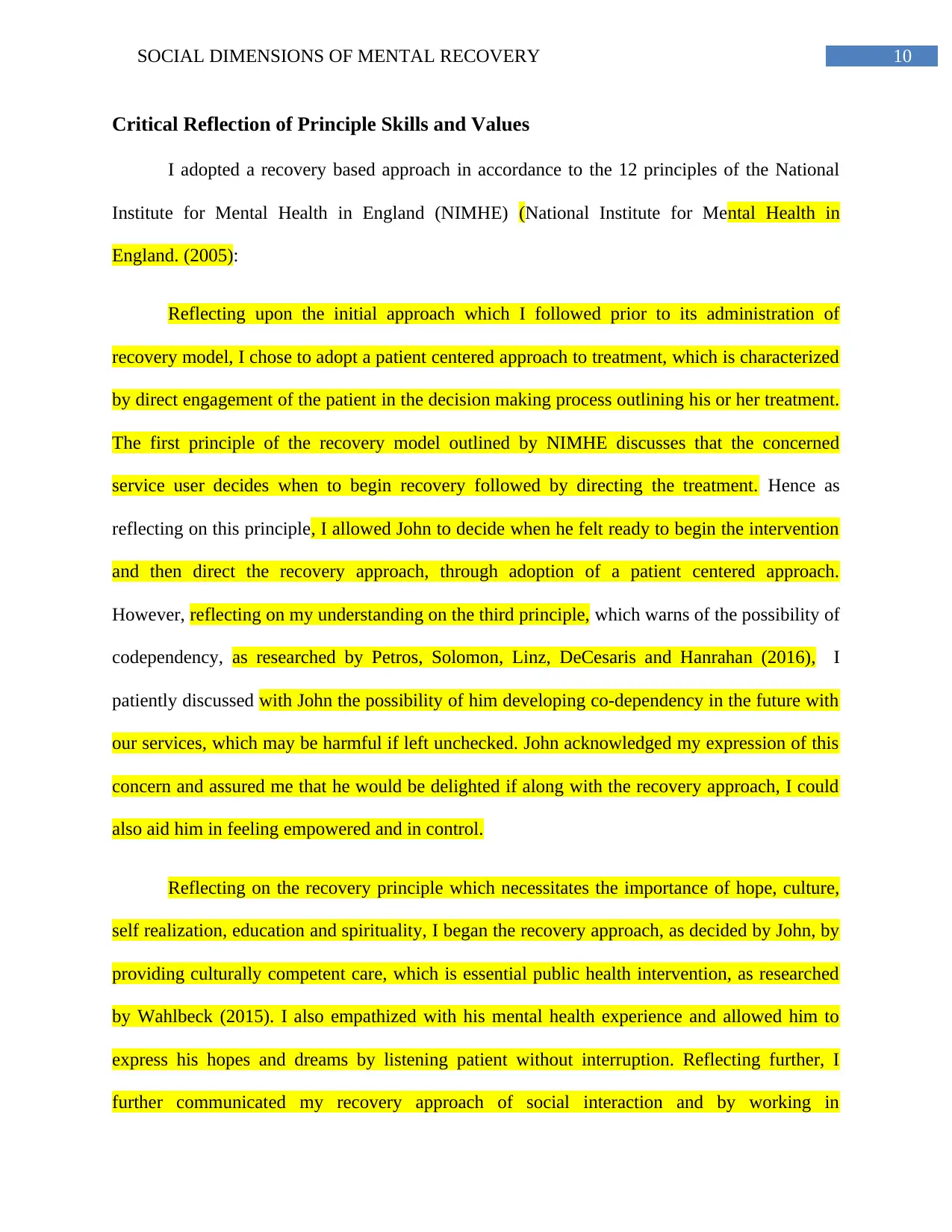
10SOCIAL DIMENSIONS OF MENTAL RECOVERY
Critical Reflection of Principle Skills and Values
I adopted a recovery based approach in accordance to the 12 principles of the National
Institute for Mental Health in England (NIMHE) (National Institute for Mental Health in
England. (2005):
Reflecting upon the initial approach which I followed prior to its administration of
recovery model, I chose to adopt a patient centered approach to treatment, which is characterized
by direct engagement of the patient in the decision making process outlining his or her treatment.
The first principle of the recovery model outlined by NIMHE discusses that the concerned
service user decides when to begin recovery followed by directing the treatment. Hence as
reflecting on this principle, I allowed John to decide when he felt ready to begin the intervention
and then direct the recovery approach, through adoption of a patient centered approach.
However, reflecting on my understanding on the third principle, which warns of the possibility of
codependency, as researched by Petros, Solomon, Linz, DeCesaris and Hanrahan (2016), I
patiently discussed with John the possibility of him developing co-dependency in the future with
our services, which may be harmful if left unchecked. John acknowledged my expression of this
concern and assured me that he would be delighted if along with the recovery approach, I could
also aid him in feeling empowered and in control.
Reflecting on the recovery principle which necessitates the importance of hope, culture,
self realization, education and spirituality, I began the recovery approach, as decided by John, by
providing culturally competent care, which is essential public health intervention, as researched
by Wahlbeck (2015). I also empathized with his mental health experience and allowed him to
express his hopes and dreams by listening patient without interruption. Reflecting further, I
further communicated my recovery approach of social interaction and by working in
Critical Reflection of Principle Skills and Values
I adopted a recovery based approach in accordance to the 12 principles of the National
Institute for Mental Health in England (NIMHE) (National Institute for Mental Health in
England. (2005):
Reflecting upon the initial approach which I followed prior to its administration of
recovery model, I chose to adopt a patient centered approach to treatment, which is characterized
by direct engagement of the patient in the decision making process outlining his or her treatment.
The first principle of the recovery model outlined by NIMHE discusses that the concerned
service user decides when to begin recovery followed by directing the treatment. Hence as
reflecting on this principle, I allowed John to decide when he felt ready to begin the intervention
and then direct the recovery approach, through adoption of a patient centered approach.
However, reflecting on my understanding on the third principle, which warns of the possibility of
codependency, as researched by Petros, Solomon, Linz, DeCesaris and Hanrahan (2016), I
patiently discussed with John the possibility of him developing co-dependency in the future with
our services, which may be harmful if left unchecked. John acknowledged my expression of this
concern and assured me that he would be delighted if along with the recovery approach, I could
also aid him in feeling empowered and in control.
Reflecting on the recovery principle which necessitates the importance of hope, culture,
self realization, education and spirituality, I began the recovery approach, as decided by John, by
providing culturally competent care, which is essential public health intervention, as researched
by Wahlbeck (2015). I also empathized with his mental health experience and allowed him to
express his hopes and dreams by listening patient without interruption. Reflecting further, I
further communicated my recovery approach of social interaction and by working in
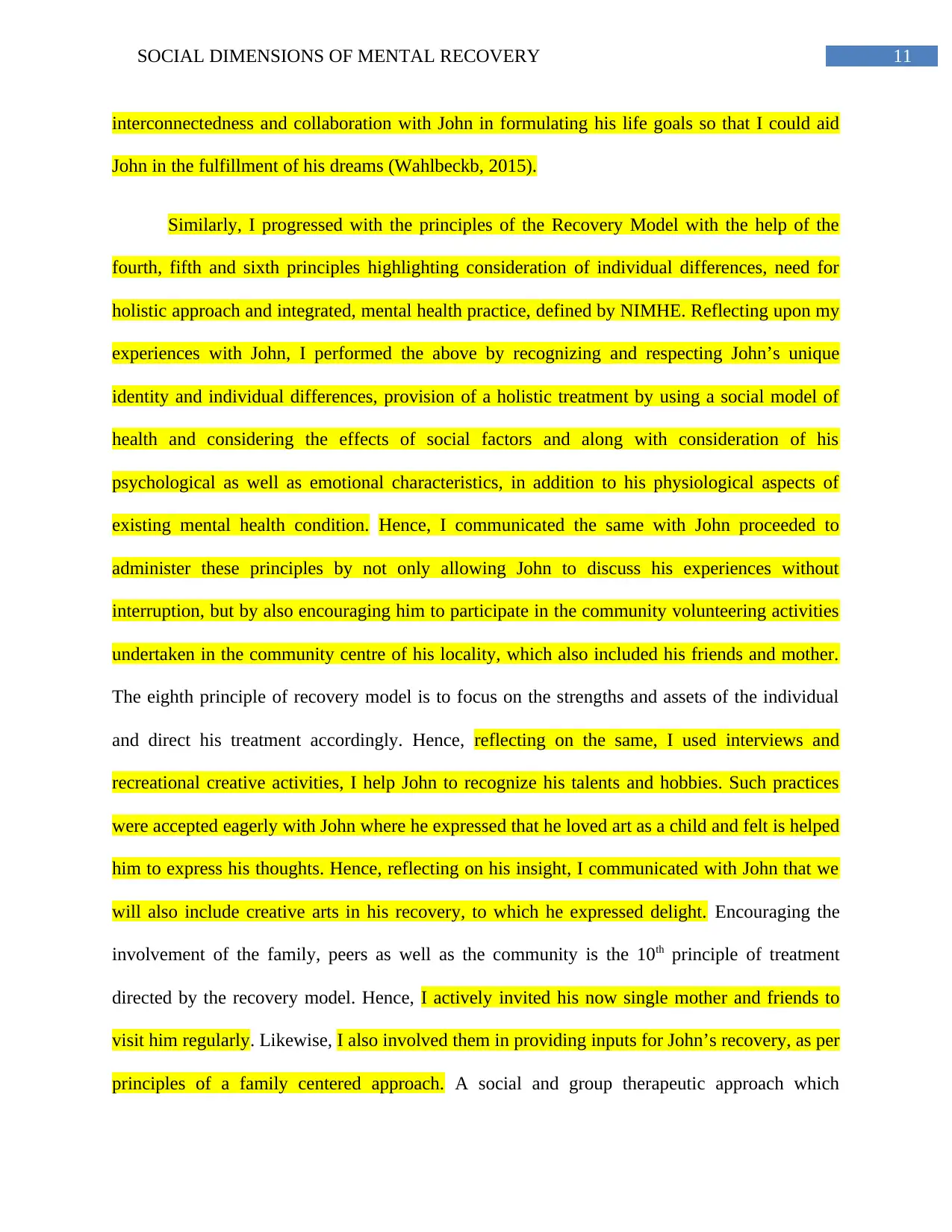
11SOCIAL DIMENSIONS OF MENTAL RECOVERY
interconnectedness and collaboration with John in formulating his life goals so that I could aid
John in the fulfillment of his dreams (Wahlbeckb, 2015).
Similarly, I progressed with the principles of the Recovery Model with the help of the
fourth, fifth and sixth principles highlighting consideration of individual differences, need for
holistic approach and integrated, mental health practice, defined by NIMHE. Reflecting upon my
experiences with John, I performed the above by recognizing and respecting John’s unique
identity and individual differences, provision of a holistic treatment by using a social model of
health and considering the effects of social factors and along with consideration of his
psychological as well as emotional characteristics, in addition to his physiological aspects of
existing mental health condition. Hence, I communicated the same with John proceeded to
administer these principles by not only allowing John to discuss his experiences without
interruption, but by also encouraging him to participate in the community volunteering activities
undertaken in the community centre of his locality, which also included his friends and mother.
The eighth principle of recovery model is to focus on the strengths and assets of the individual
and direct his treatment accordingly. Hence, reflecting on the same, I used interviews and
recreational creative activities, I help John to recognize his talents and hobbies. Such practices
were accepted eagerly with John where he expressed that he loved art as a child and felt is helped
him to express his thoughts. Hence, reflecting on his insight, I communicated with John that we
will also include creative arts in his recovery, to which he expressed delight. Encouraging the
involvement of the family, peers as well as the community is the 10th principle of treatment
directed by the recovery model. Hence, I actively invited his now single mother and friends to
visit him regularly. Likewise, I also involved them in providing inputs for John’s recovery, as per
principles of a family centered approach. A social and group therapeutic approach which
interconnectedness and collaboration with John in formulating his life goals so that I could aid
John in the fulfillment of his dreams (Wahlbeckb, 2015).
Similarly, I progressed with the principles of the Recovery Model with the help of the
fourth, fifth and sixth principles highlighting consideration of individual differences, need for
holistic approach and integrated, mental health practice, defined by NIMHE. Reflecting upon my
experiences with John, I performed the above by recognizing and respecting John’s unique
identity and individual differences, provision of a holistic treatment by using a social model of
health and considering the effects of social factors and along with consideration of his
psychological as well as emotional characteristics, in addition to his physiological aspects of
existing mental health condition. Hence, I communicated the same with John proceeded to
administer these principles by not only allowing John to discuss his experiences without
interruption, but by also encouraging him to participate in the community volunteering activities
undertaken in the community centre of his locality, which also included his friends and mother.
The eighth principle of recovery model is to focus on the strengths and assets of the individual
and direct his treatment accordingly. Hence, reflecting on the same, I used interviews and
recreational creative activities, I help John to recognize his talents and hobbies. Such practices
were accepted eagerly with John where he expressed that he loved art as a child and felt is helped
him to express his thoughts. Hence, reflecting on his insight, I communicated with John that we
will also include creative arts in his recovery, to which he expressed delight. Encouraging the
involvement of the family, peers as well as the community is the 10th principle of treatment
directed by the recovery model. Hence, I actively invited his now single mother and friends to
visit him regularly. Likewise, I also involved them in providing inputs for John’s recovery, as per
principles of a family centered approach. A social and group therapeutic approach which
⊘ This is a preview!⊘
Do you want full access?
Subscribe today to unlock all pages.

Trusted by 1+ million students worldwide
1 out of 22
Related Documents
Your All-in-One AI-Powered Toolkit for Academic Success.
+13062052269
info@desklib.com
Available 24*7 on WhatsApp / Email
![[object Object]](/_next/static/media/star-bottom.7253800d.svg)
Unlock your academic potential
Copyright © 2020–2025 A2Z Services. All Rights Reserved. Developed and managed by ZUCOL.




